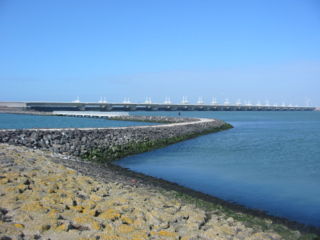This page is based on this
Wikipedia article Text is available under the
CC BY-SA 4.0 license; additional terms may apply.
Images, videos and audio are available under their respective licenses.

An air base is an aerodrome used as a military base by a military force for the operation of military aircraft.

A sandbag is a bag or sack made of hessian (burlap), polypropylene or other sturdy materials that is filled with sand or soil and used for such purposes as flood control, military fortification in trenches and bunkers, shielding glass windows in war zones, ballast, counterweight, and in other applications requiring mobile fortification, such as adding improvised additional protection to armoured vehicles or tanks.

A bulkhead is a retaining wall, such as a bulkhead within a ship or a watershed retaining wall. It may also be used in mines to contain flooding.

Breakwaters are structures constructed near the coasts as part of coastal management or to protect an anchorage from the effects of both weather and longshore drift.

A hardened aircraft shelter (HAS) or protective aircraft shelter (PAS) is a reinforced hangar to house and protect military aircraft from enemy attack. Cost considerations and building practicalities limit their use to fighter size aircraft.

A gabion is a cage, cylinder, or box filled with rocks, concrete, or sometimes sand and soil for use in civil engineering, road building, military applications and landscaping.

Coastal management is defence against flooding and erosion, and techniques that stop erosion to claim lands.

Hoxton Park Airport was a general aviation aerodrome in south-western Sydney, New South Wales, Australia.

Promontory Point is a man-made peninsula jutting into Lake Michigan. It is located in Chicago's Burnham Park. The Point was constructed from landfill and by the late 1930s was protected by a seawall or revetment. The revetment was designed and constructed by Chicago Park District engineers and consists of limestone blocks arranged in a series of four steps leading to a promenade.

Madang Airport, is an airport located in Madang, Papua New Guinea.

Perranporth Airfield airfield is located 1.5 NM southwest of Perranporth and 6 NM southwest of Newquay, in the village of Trevellas, Cornwall, England, United Kingdom. It is a former Second World War Royal Air Force fighter station.

Royal Air Force Leiston or more simply RAF Leiston is a former Royal Air Force station located 1.5 km (0.93 mi) northwest of Leiston and 1 km (0.62 mi) south of Theberton, Suffolk, England.
Ulan-Ude Vostochny Airport is an airport in the Buryat Republic, Russia located 9 km east of Ulan Ude. It services medium-size airliners. The airfield served as a bomber staging base. There is considerable tarmac space, with three 400x125m tarmacs and a few alert revetments.

A blast wall is a barrier designed to protect vulnerable buildings or other structures and the people inside them from the effects of a nearby explosion, whether caused by industrial accident, military action or terrorism.
A honeycomb sea wall is a coastal defense structure that protects against strong waves and tides. It is constructed as a sloped wall of ceramic or concrete blocks with hexagonal holes on the slope, which makes it look like a honeycomb, hence the name of the unit. Its role is to capture sand and to discharge wave energy.

King Arthur's Hall is a megalithic enclosure on Bodmin Moor in Cornwall, England. It is thought to be a late Neolithic or early Bronze Age ceremonial site.

The Port Moresby Airfield Complex was a World War II military airfield complex, built near Port Moresby, Papua and New Guinea. It was used during the Battle of New Guinea as a base of Allied air operations primarily in 1942 and early 1943. It later became a support base as the battle moved to the north and western part of New Guinea. It was closed and the facility turned over to civil authorities after the end of the war in September 1945.

The Lithgow Heavy Anti Aircraft Gun Stations and Dummy Station is a heritage-listed former gun emplacements, anti aircraft gun batteries and dummy batteries and now disused railway signal box located via Kirkley Street, Bowenfels, City of Lithgow, New South Wales, Australia. It was built from 1941 to 1942 by Water Conservation & Irrigation Commission, Defence. It is also known as Lithgow Anti Aircraft Gun Emplacements and Heavy Anti Aircraft guns 3.7 inch anti aircraft guns. The property is owned by Lithgow City Council. It was added to the New South Wales State Heritage Register on 5 August 2011.

















